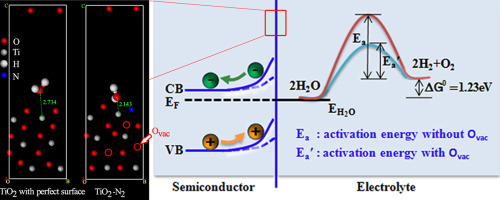Nano Energy ( IF 16.8 ) Pub Date : 2017-12-15 , DOI: 10.1016/j.nanoen.2017.12.024 Xiaowei Lv , Leiming Tao , Minglei Cao , Xin Xiao , Mingkui Wang , Yan Shen

|
Charge injection at the semiconductor/electrolyte interface is one of critical limiting factors in achieving efficient photoelectrochemical (PEC) water splitting. Herein, we demonstrate a concept-driven strategy of self-catalyzed oxygen evolution in PEC system to realize efficient and stable charge injection by introducing oxygen vacancies (Ovac) in the nitrogen-doped TiO2 (N-TiO2) which plays dual role of light absorber and electrochemical catalyst. DFT calculation reveals the oxygen vacancies confined in the N-TiO2 films lower its adsorption energy of H2O, leading to a dramatically increase in oxygen evolution reaction (OER) efficiency. Therefore significantly improved charge injection efficiency of 94.6% at 1.23 VRHE can be achieved for the N-TiO2 with oxygen vacancies (TiO2-N2) films in the absence of any oxygen evolution catalyst. More interestingly, the TiO2-N2 electrode exhibits excellent stability with negligible photocurrent decay (2%) after 4 h of PEC reaction at 1.23 VRHE under AM 1.5G illumination. Systematic studies reveal that the O vacancies in the N-TiO2 play an important role in increasing the electrochemically active surface area and the reactivity of active sites along with reduction of anodic overpotential for oxygen evolution. It is worth mentioning that, to the best of our knowledge, this is the first report on self-catalyzed oxygen evolution in PEC systems. Consequently, the strategy provides an alternative route for efficient and stable PEC water splitting.
中文翻译:

通过自催化析氧提高光电化学水的氧化效率:以TiO 2为例
在半导体/电解质界面处的电荷注入是实现有效的光电化学(PEC)水分解的关键限制因素之一。本文中,我们展示了一种概念驱动的PEC系统中自催化氧释放的策略,该方法通过在起双重作用的掺氮TiO 2(N-TiO 2)中引入氧空位(O vac)来实现高效稳定的电荷注入。吸收剂和电化学催化剂的制备。DFT计算表明,限制在N-TiO 2薄膜中的氧空位降低了其对H 2的吸附能O,导致氧气释放反应(OER)效率大大提高。因此,在不存在任何析氧催化剂的情况下,对于具有氧空位(TiO 2 -N 2)膜的N-TiO 2,可以实现在1.23 V RHE时94.6%的电荷注入效率的显着提高。更有趣的是,TiO 2 -N 2电极在1.23 V RHE下在AM 1.5G光照下进行PEC反应4小时后,具有优异的稳定性,光电流衰减可忽略不计(2%)。系统研究表明,N-TiO 2中的O空位在增加电化学活性表面积和活性位点的反应性以及减少氧气析出的阳极过电势方面起着重要作用。值得一提的是,就我们所知,这是关于PEC系统中自催化氧释放的第一份报告。因此,该策略提供了有效而稳定的PEC水分解的替代途径。











































 京公网安备 11010802027423号
京公网安备 11010802027423号